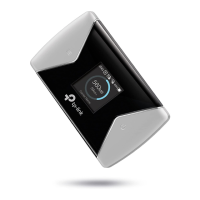
Do you have a question about the TP-Link M7450 and is the answer not in the manual?
| Device type | Cellular wireless network equipment |
|---|---|
| Certification | CE, RoHS |
| Product color | Black, Grey |
| Card reader integrated | Yes |
| Compatible memory cards | SD |
| Data network | EDGE, GPRS, GSM, HSPA, LTE, UMTS |
| GSM bands supported | 850, 900, 1800, 1900 MHz |
| UMTS bands supported | 900, 2100 MHz |
| Number of simultaneous SIM cards | 1 |
| Battery capacity | 3000 mAh |
| Power source type | Battery |
| Wi-Fi standards | 802.11a, 802.11b, 802.11g, Wi-Fi 4 (802.11n), Wi-Fi 5 (802.11ac) |
| WLAN data transfer rates supported | 300 Mbit/s |
| Display diagonal | 1.44 \ |
| Operating frequency | 2400 & 5000 MHz |
| Storage temperature (T-T) | -20 - 60 °C |
| Operating temperature (T-T) | 0 - 35 °C |
| Storage relative humidity (H-H) | 5 - 90 % |
| Operating relative humidity (H-H) | 10 - 90 % |
| Security algorithms | WPA-PSK, WPA2-PSK |
| Antenna type | Internal |
| Maximum memory card size | 32 GB |
| 4G standard | LTE-TDD & LTE-FDD |
| 2G standards | EDGE, GPRS |
| 3G standards | DC-HSDPA, HSPA, HSPA+, UMTS |
| 4G bands supported | 800, 900, 1800, 2100, 2600 MHz |
| Display type | TFT |
| Market positioning | Portable |
| Windows operating systems supported | Windows 10, Windows 7, Windows 8, Windows 8.1, Windows Vista, Windows XP |
| Ethernet LAN | No |
| Package depth | 101 mm |
| Package width | 149 mm |
| Package height | 60 mm |
| Package weight | 250 g |
| Cables included | Micro-USB |
| Harmonized System (HS) code | 85176990 |
| Depth | 66.5 mm |
|---|---|
| Width | 112.5 mm |
| Height | 16 mm |
Overview of the Mobile Wi-Fi's capabilities and features, including connectivity and battery life.
Step-by-step guide on inserting SIM and SD cards and powering on the device.
Instructions on connecting devices using SSID/password and WPS methods.
How to log in to the web management page using a smartphone.
Monitoring and revising the amount of data used on the Mobile Wi-Fi.
Setting data limits and alerts to control usage and prevent overages.
Changing SSID, password, and hiding network broadcast for security.
Restricting unauthorized devices from accessing the Wi-Fi network.
Resetting the device to factory defaults.
Installing the latest firmware for improved features and performance.